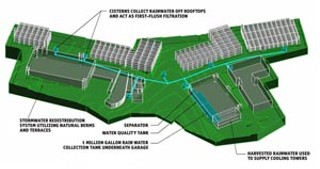AMD Sets Its Site on Lantana
Company trumpets facility greenbuilding; opponents ask what's downstream?
By Amy Smith, Fri., Dec. 23, 2005

Click for a larger image
With all the fanfare usually accorded a major groundbreaking celebration, Advanced Micro Devices unveiled its specific plans for a new Lantana campus last week. Although still months away from actual construction on its planned site in Southwest Austin, the company is trying to rally citywide enthusiasm for its controversial plans to build a $230 million office complex in the contributing zone of the sensitive Barton Springs segment of the Edwards Aquifer. (See "Back to the Trenches," Dec. 16.)
In making its formal announcement, AMD has pulled out all the stops to promote its site development plan as a world-glass greenbuilding project that it says will:
• Reduce commuter traffic citywide by relocating closer to the residences of most of the company's 2,000 white-collar employees;
• Collect 100% of rainwater runoff from rooftops and top floors of parking garages, and use that water both to irrigate native landscape and for the campus evaporative cooling system;
• Restore and enhance native vegetation to absorb rainwater and thus avoid the need for retention ponds;
• Cluster office buildings and parking garages on the less-sensitive 33 acres of the 58-acre site at Southwest Parkway and William Cannon.
For its efforts, the company expects to secure the highest honor – gold-level certification – from the U.S. Green Building Council, making it one of the largest commercial developments in the country to achieve such recognition.
Setting a New Standard ... for What?
Even among the project's opponents, no one takes issue with the site plan's ultra-green personality. The project – christened "AMD Lone Star" – is destined to put both AMD and Austin on the map as a model for green building. But opponents of AMD's move to the watershed – which includes a coalition of environmental and neighborhood leaders as well as former Mayor Kirk Watson – insist that the site selection itself defeats the purpose of Smart Growth and environmental sustainability.
For the past 20 years, city leaders have successfully steered major employers away from the aquifer and into more desirable development areas east, north, and Downtown. AMD would be the first major employer in more than two decades to build a major facility in the area. The Oak Hill community of Southwest Austin largely supports the company's plan, while environmentalists and Smart Growth advocates remain staunchly opposed to AMD defying longstanding community planning values. It's all well and good for AMD to employ greenbuilding standards on its own site, opponents say. But in the long run, how will that benefit an environmentally sensitive area where more development is bound to follow?
"None of the greenbuilding tricks will do a thing to address the off-site pollution from secondary growth catalyzed by AMD's development, from AMD's own employees driving back and forth across the aquifer, or from the hundreds of millions of dollars in highway construction projects that will be necessary to support a satellite [downtown region] on Southwest Parkway," said Bill Bunch, executive director of the Save Our Springs Alliance, one of the most vocal opponents of the project.
But another environmentalist, Steve Windhager, director of landscape restoration with the Lady Bird Johnson Wildflower Center and a consultant on the AMD project, countered that the company will set a new standard for development in the area. "I tend to think we can provide a real model for other development ... my hope is to make this the new standard."
Off the Grid
Windhager, an amiable, plainspoken scientist, says that AMD struck a positive note with him early in the design process. Last May, Austin greenbuilding expert and AMD consultant Gail Vittori invited Windhager to participate in a design charrette [a roundtable discussion] process to determine the best possible green design for this particular location. "Doing a design charrette meant starting over," Windhager said. The company's willingness to scrap its initial conceptual design convinced him that AMD officials were serious about going above and beyond what was required of them. Windhager spent hours and days "crawling over the site" and pinpointing the more sensitive habitat areas that would be off limits to development. "Most companies," he said, "bring the [environmental] consultants in after the fact, when it's too late to change anything."
Windhager is particularly excited about the rainwater harvesting system – a state-of-the-art operation that will include eight separate 45,000 gallon tanks strategically stationed around the campus, plus a million-gallon cistern under one of the parking structures. Water from this tank will supplement the potable water used in the evaporative cooling system.
Long before the bulldozing is scheduled to start this spring, Windhager will begin harvesting some 20,000 existing plants that will be housed and nurtured at the Wildflower Center before being replanted at the campus. "This is the first corporate campus of its type that has completely gone off the grid from an environmental standpoint," he said.
Meanwhile, opponents have vowed to step up their efforts to prevent AMD from breaking ground at the site. Last week's news reports about the company's plans drove home the fact that a major employer is locating in an area that goes against three major community planning road maps, Bunch said. "If AMD can locate in the Barton Springs watershed, why not other large employers?" he continued. "Twenty five years of community planning will be thrown out the window. No good can come of any project of this scale that begins with so much arrogance, deception, and disrespect for the community."
For more info on the AMD plans, see www.amdlonestar.com. For more on the opposition to the AMD plans, see www.moveamd.com. ![]()
Got something to say on the subject? Send a letter to the editor.









